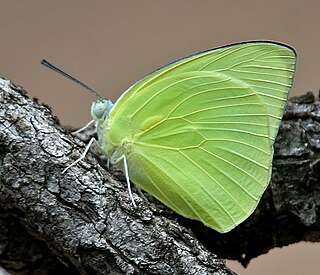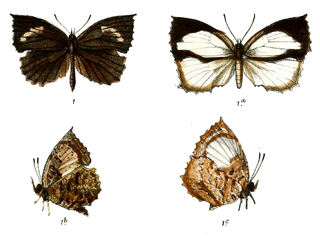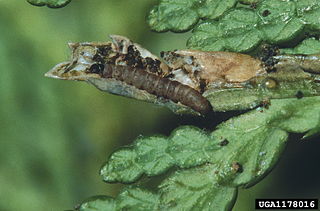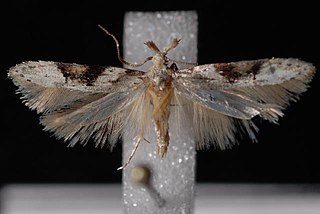
Catopsilia pomona, the common emigrant or lemon emigrant, is a medium-sized pierid butterfly found in Asia and parts of Australia. The species gets its name from its habit of migration. Some early authors considered them as two distinct species Catopsilia crocale and Catopsilia pomona.

Allotinus drumila, the crenulate darkie, is a small butterfly found in India, Burma, Thailand, Laos, Vietnam, and Yunnan (China) that belongs to the lycaenids or blues family.

Hypolimnas misippus, the Danaid eggfly, mimic, or diadem, is a widespread species of nymphalid butterfly. It is well known for polymorphism and mimicry. Males are blackish with distinctive white spots that are fringed in blue. Females are in multiple forms that include male-like forms while others closely resemble the toxic butterflies Danaus chrysippus and Danaus plexippus.

The Indian fritillary is a species of butterfly of the nymphalid or brush-footed family. It is usually found from south and southeast Asia to Australia.

Plusia festucae is a species of moth of the family Noctuidae. It is found throughout the Palearctic realm from Ireland to Japan.

Coleotechnites thujaella is a moth of the family Gelechiidae. It is found in the north-eastern parts of the United States, as well as Canada.

Cosmopterix chisosensis is a moth of the family Cosmopterigidae. It is known from Argentina and the United States.
Paraplatyptilia edwardsii is a moth of the family Pterophoridae. It is found in North America.
Coleotechnites argentiabella is a moth of the family Gelechiidae. It is found in North America, where it has been recorded from Texas.

Coleotechnites atrupictella is a moth of the family Gelechiidae. It is found in North America, where it has been recorded from Alberta, British Columbia, Indiana, Maine, Massachusetts, Michigan, New Brunswick, Newfoundland, New York, Ontario, Pennsylvania, Saskatchewan and Washington.
Coleotechnites colubrinae is a moth of the family Gelechiidae. It is found in North America, where it has been recorded from Texas.
Coleotechnites condignella is a moth of the family Gelechiidae. It is found in North America, where it has been recorded from California, Arizona, South Carolina and Florida.
Coleotechnites cristatella is a moth of the family Gelechiidae. It is found in North America, where it has been recorded from Kentucky.
Coleotechnites nigritus is a moth of the family Gelechiidae. It is found in North America, where it has been recorded from Florida, Kentucky and New Hampshire.
Coleotechnites obliquistrigella is a moth of the family Gelechiidae. It is found in North America, where it has been recorded from Alabama, Florida, Kentucky, Maine, Mississippi, Ohio and Tennessee.
Coleotechnites petulans is a moth of the family Gelechiidae. It is found in Colombia, Ecuador and Peru.
Coleotechnites stanfordia, the cypress leaf miner, is a moth of the family Gelechiidae. It is found in the United States, where it has been recorded from California.
Agonochaetia conspersa is a moth of the family Gelechiidae. It is found in North America, where it has been recorded from Alberta and Montana.
Paraspastis circographa is a moth of the family Depressariidae and the only species in the genus Paraspastis. It is found in Guyana.

Homostinea curviliniella is a moth of the family Tineidae. It is found in Cuba and North America, where it has been recorded from most of the eastern half of the United States and Arizona.







